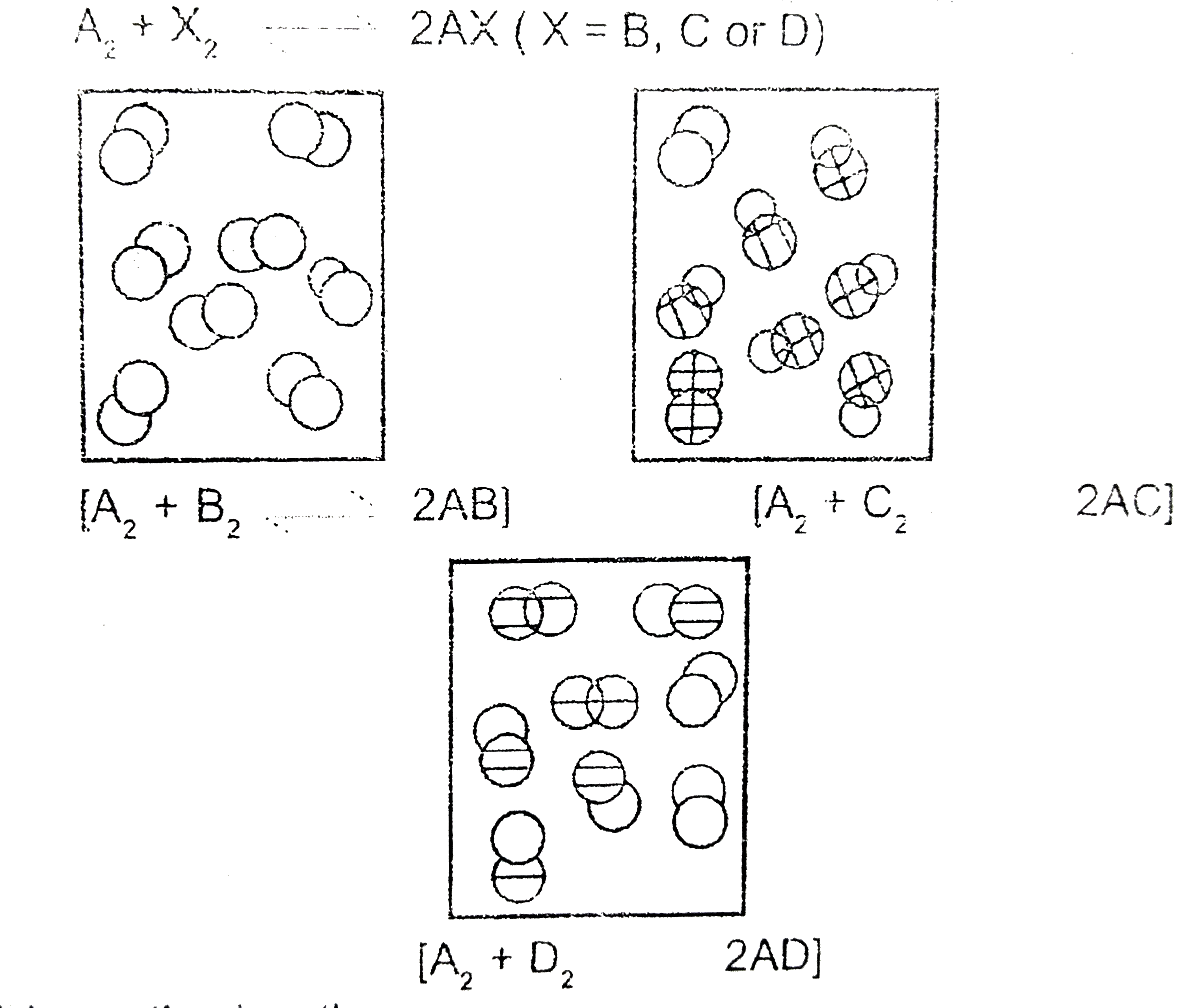Complete Solutions to Advanced Level Problems (Part-3)(Stage-1) of chapter CHEMICAL EQUILIBRIUM of Class 11 book with complete answers and questions
| Class 11 | CHEMISTRY |
| Chapter | CHEMICAL EQUILIBRIUM |
| RESONANCE | Advanced Level Problems (Part-3)(Stage-1) |
| Number Of Questions | 38 |
| Academic Year | 2023-24 |
If the equilibrium constant for the reaction `0.125`.
`P_(4(g))+6Cl_(2(g))hArr4PCl_(3(g))`
The value of equilibrium constant for this reaction
`4PCl_(3(g))hArrP_(4(g))+6Cl_(2(g))`
View SolutionThe free energy change for a reversible reaction at equilibrium is:
zero
small positive
small negative
large positive.
View SolutionPure ammonia is placed in a vessel at a temperature where its dissociation constant `(alpha)` is appreciable. At equilibrium,
View SolutionFor a spontaneous process :-
View SolutionFor a given reversible reaction at a fixed temperature, equilibrium constants `K_(p)` and `K_(c)` are related by ………
View SolutionIn the gaseous phase reaction
`C_(2)H_(4) +H_(2) hArr C_(2)H_(6),` the equilibrium constant can be expressed in the units to :
View SolutionThe equilibrium constant for the reaction `H_(2)+Br_(2)hArr2HBr` is `67.8` at `300 K`. The equilibrium constant for the dissociation of `HBr` is:
View SolutionThe equilibrium constant `(K)` for the reaction. `A+2BhArr2C+D` is:
View SolutionA solid mixture(5.000 g) consisting of lead nitrate and sodium nitrate was heated below 600°C until the weight of the residue was constant. If the loss in weight is 28%, find the amount of lead nitrate and sodium nitrate in the mixture.
View SolutionThe following pictures represents the equilibrium state for three different reactions of the type
`A_(2)+X_(2)hArr2AX` `(X=B,C "or" D)`

Which reaction has the largest equilibrium constant?
View SolutionMethanol `(CH_(3)OH)` is manufactured by reaction of carbon monoxide with hydrogen in the presence of `ZnO //Cr_(2)O_(3)` catalyst.
`CO+2H_(2(g)),[DeltaH^(@)=-91KJ`]
What happens to the amount of methanol when an equilibrium mixture of reactants and products is subjected to rise in temperature?
View SolutionFor the reversible reaction,`A+BhArrC`, the specific reaction rates for forward and reverse reactions are `1.25xx10^(3) "and" 2.75xx10^(4)` respectively. The equilibrium constant for the reaction is:
View SolutionThe equilibrium constant for the gaseous reaction `H_(2)+Cl_(2)hArr2HCl` is given by
View SolutionGiven the equilibrium system
`NH_(4)Cl(s)hArr NH_(4)^(+)(aq)+Cl^(-)(aq) (DeltaH=+"3.5 kcal/mol").`
What change will shift the equilibrium to the right?
View SolutionA catalyst increases the
View SolutionFor the reaction, `N_(2)+3H_(2)hArr2NH_(3)`, the units of `K_(c) "and" K_(p)` respectively are:
View SolutionA 0.20 M solution of methanoic acid has degree of ionization of 0.032. Its dissociation constant would be
View SolutionThe equilibrium constant for the reaction `N_(2)+3H_(2)hArr2NH_(3)` is 70 at a certain temperature. Hence, equilibrium constant for the reaction `NH_(3)hArr(1)/(2)N_(2)+(3)/(2)H_(2)` of the same temperature will be approximately
View SolutionFor the reaction:
`4NH_(3)(g)+7O_(2(g))hArr4NO_(2(g))+6H_(2)O_(g).K_(p)` is related to `K_(c)` by
View SolutionWhen `K_(c)gt1` for a chemical reaction,
View SolutionWhat will be the effect to increased pressure in the following equilibrium reaction ?
(i) `H_2(g) +I_2(g) hArr 2HI(g)`
(ii) `N_2(g)+3H_2(g) hArr 2NH_3(g)`
(iii) `N_2O_4(g) hArr 2NO_2(g)`
View SolutionIn which reaction will an increase in the volume of the container favor the formation of products?
View SolutionWhich of the following changes the value of the equilibrium constant ?
View SolutionConsider the equilibrium reaction:
`4NH_(3((g)))+3O_(2((g)))hArr2N_(2((g)))+6H_(2)O_((g))`
`(DeltaH=-1268KJ)`
Which change will cause the reaction to shift to the right?
View SolutionEquilibrium constants `K_(1)` and `K_(2)` for the following equilibria
`NO(g) +1//2O_(2)(g) overset(K_(1))(hArr) NO_(2)(g)` and
`2NO_(2)(g) overset(K_(2))(hArr)2NO(g)+O_(2)(g)`
are related as
View SolutionA catalyst speeds up a chemical reraction by
View SolutionFor the reaction `2HIhArrH_(2)(g)+I_(2)(g)`
View Solutionconsider the following gaseous equilibrium with equilibrium constant `K_(1)` and `K_(2)` respectively
`SO_(2)(g)+ 1//2O_(2)hArrSO_(3)(g)`
`2SO_(3)(g)hArr2SO_(2)(g)+O_(2)(g)`
The equilibrium constants are related as
View SolutionThe equilibrium constant `K_(c)` for the reaction,
`2NaHCO_(3)(s)hArrNa_(2)CO_(3)(s)+CO_(2)(g)+H_(2)O(g)`
View SolutionFor the following reaction, the value of `K` change with
`N_(2)(g)+O_(2)(g) lt lt 2NO(g), DeltaH=+180 kJ mol^(-1)`
View SolutionFor the reaction `PCl_(3)(g)+Cl_(2)(g)rarrPCl_(5)(g),K_(c)` is 26 at `250^(@)C`. `K_(p)` at the same temperature is `(R=8.314JK^(-1)mol^(-1))`
View SolutionAt `445^(@)C,K_(c)` for the following reaction is `0.020`.
`2HI(g)rarrH_(2)(g)+I_(2)(g)`
A mixture of `H_(2),I_(2)` and `HI` in a vessel at `445^(@)C` has the following concentration: `[HI]=2.0M,[H_(2)]=0.50M` and `[I_(2)]=0.10M`. The statement that is true concerning the reaction quotient, `Q_(c)` is:
View SolutionA catalyst accelerates a reaction primarily by stablizing the
View SolutionThe oxidation of `SO_(2)` to `SO_(3)` is an exothermic reaction. The yield of `SO_(3)` will be maximum if :
View SolutionIn which of the following reaction `K_(p) gt K_(c)` ?
View SolutionThe `K_(p)//K_(c)` ratio for the reaction:
`4NH_(3)(g)+7O_(2)(g)hArr4NO(g)+6H_(2)O(g)`, at,`127^(@)C` is
View Solution`K_(p)` for the reaction given below is `1.36 "at" 499K`. Which of the
following equations can be used to calculate `K_(c)` for this reaction?
`N_(2)O_(5(g))rarrNO_(2(g))+NO_(3(g))`
View SolutionAt `700K`, for the reaction `2SO_(2)(g)+O_(2)(g)hArr2SO_(3)(g)` the `K_(p) "is" 3.2xx10^(4)`. At the same temperature the `K_(p)` for the reaction `SO_(3)(g)hArrSO_(2)(g)+0.50O_(2)(g)` is:
View Solution
Advanced Level Problems (Part-3)(Stage-1) questions and complete solutions for chapter CHEMICAL EQUILIBRIUM of RESONANCE ENGLISH of Class 11
All Exercises from RESONANCE Class 11 CHEMISTRY CHEMICAL EQUILIBRIUM
- (MSPs)
- Advanced Level Problems (Part-1)
- Advanced Level Problems (Part-2)(Section-1)
- Advanced Level Problems (Part-2)(Section-2)
- Advanced Level Problems (Part-2)(Section-3)
- Advanced Level Problems (Part-3)(Stage-1)
- Advanced Level Problems (Part-3)(Stage-2)
- Advanced Level Problems (Part-3)(Stage-5)
- Board Level Exercise
- Exercise-1 (Part-1)
- Exercise-1 (Part-2)
- Exercise-2 (Part-1)
- Exercise-2 (Part-2)
- Exercise-2 (Part-3)
- Exercise-2 (Part-4)
- Exercise-3 (Part-1)
- Exercise-3 (Part-2)
- INORGANIC CHEMISTRY(Metallurgy)
- ORGANIC CHEMISTRY(Alkyl Halide, Alcohol,Phenol,Ether)
- PHYSICAL CHMISTRY (CHMICAL EQUILIBRIUM)
- Solved examples